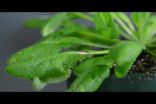(Press-News.org) Today, doctors who really want to see if a wound is healing have to do a biopsy or some other invasive technique that, besides injuring an already injured patient, can really only offer information about a small area. But a technology called hyperspectral imaging offers doctors a noninvasive, painless way to discriminate between healthy and diseased tissue and reveal how well damaged tissue is healing over a wide area. The catch? A lack of calibration standards is impeding its use.
After a successful non-human trial, researchers at the National Institute of Standards and Technology (NIST) have started gathering data on how human skin looks under various wavelengths of light in order to develop these badly needed standards.*
Unlike consumer digital cameras and the human eye, which only see red, green and blue light, a relatively narrow portion of the electromagnetic spectrum, each pixel of a hyperspectral image captures information for hundreds of narrow spectral bands—from the ultraviolet to the infrared.
According to NIST researcher David Allen, being sensitive to so many wavelengths means hyperspectral imagers can see many different things that humans can't see, including the amount of oxygen in human tissues, an indicator of healing.
"The potential of the technology has been proven, but the problem is that researchers are simply lacking a way to assure consistent results between labs," says Allen. "Standards development has itself been hindered by a lack of human skin reflectance data, especially in the ultraviolet and short-wave infrared."
Catherine Cooksey, the project leader for the spectrophotometry program that establishes and maintains the national scale of reflectance, says that before we delve into what diseased tissue looks like hyperspectrally, we need to know what so-called "normal" tissue looks like. Furthermore, she says that they are looking to quantify the variability both within an individual and between individuals due to inherent biological differences. The initial NIST studies used 28 volunteer test subjects. The data collected included a photograph of the test area on the subject's forearm and three reflectance measurements of the test area.
"Skin reflectance varies due to skin pigmentation, tissue density, lipid content and blood volume changes," says Cooksey. "And few, if any, studies of skin reflectance have been done with an estimated measurement uncertainty that is traceable to NIST or any other national metrology institute. We need good data from a wide variety of sources, and for that we need the help of our colleagues in the community."
Once they collect enough data, the NIST researchers can feed it into NIST's Hyperspectral Image Projector, a device that creates hyperspectral scenes that have all the spectral signatures of the real thing—in this case, tissue in various stages of repair. Medical imaging technicians can then use these "digital tissue phantoms" to test their imagers' ability to discern among and detect different tissue types and conditions.
INFORMATION:
Those interested in helping to gather skin reflectance data should contact Allen (dwallen@nist.gov) or Cooksey (catherine.cooksey@nist.gov) or more information.
*C.C. Cooksey, B.K. Tsai and D.W. Allen. "A collection and statistical analysis of skin reflectance signatures for inherent variability over the 250 nm to 2500 nm spectral range." Presented at the SPIE Defense, Security & Sensing Conference, June 4, 2014, Baltimore, Md.
Seeing your true colors: Standards for hyperspectral imaging
2014-07-01
ELSE PRESS RELEASES FROM THIS DATE:
New NIST metamaterial gives light a one-way ticket
2014-07-01
The light-warping structures known as metamaterials have a new trick in their ever-expanding repertoire. Researchers at the National Institute of Standards and Technology (NIST) have built a silver, glass and chromium nanostructure that can all but stop visible light cold in one direction while giving it a pass in the other.* The device could someday play a role in optical information processing and in novel biosensing devices.
In recent years, scientists have designed nanostructured materials that allow microwave or infrared light to propagate in only one direction. ...
Fear, not data, motivates sunscreen users, research shows
2014-07-01
BUFFALO, N.Y. – We're often told that worrying can be harmful to one's health. But University at Buffalo researchers say that when it comes to preventing skin cancer, a little fear is good for you.
In a study published in the Journal of Behavioral Medicine, the UB researchers found that fear and worry about skin cancer had a bigger influence on people's use of sunscreen than information about the statistical likelihood of developing the disease.
"Most health behavior studies don't account for the more visceral, emotional reactions that lead people to do risky behaviors, ...
NIST test house exceeds goal; ends year with energy to spare
2014-07-01
The net-zero energy test house at the National Institute of Standards and Technology (NIST) in suburban Washington, D.C., not only absorbed winter's best shot, it came out on top, reaching its one-year anniversary on July 1 with enough surplus energy to power an electric car for about 1,440 miles.*
Watch the YouTube video at https://www.youtube.com/watch?v=iJZrOhPk4kg
Despite five months of below-average temperatures and twice the normal amount of snowfall, NIST's Net-Zero Energy Residential Test Facility (NZERTF) ended its one-year test run with 491 kilowatt hours ...
Biomarker predicts effectiveness of brain cancer treatment
2014-07-01
Researchers at the University of California, San Diego School of Medicine have identified a new biomarker that predicts whether glioblastoma – the most common form of primary brain cancer – will respond to chemotherapy. The findings are published in the July print issue of Oncotarget.
"Every patient diagnosed with glioblastoma is treated with a chemotherapy called temozolomide. About 15 percent of these patients derive long-lasting benefit," said Clark C. Chen, MD, PhD, vice-chairman of Academic Affairs, Division of Neurosurgery, UC San Diego School of Medicine and the ...
Plants respond to leaf vibrations caused by insects' chewing, MU study finds
2014-07-01
VIDEO:
Experiments by Heidi Appel and Rex Cocroft at the University of Missouri mark the first time scientists have shown that a plant responds to an ecologically relevant sound in its...
Click here for more information.
COLUMBIA, Mo. – Previous studies have suggested that plant growth can be influenced by sound and that plants respond to wind and touch. Now, researchers at the University of Missouri, in a collaboration that brings together audio and chemical analysis, have ...
Reigning in chaos in particle colliders yields big results
2014-07-01
WASHINGTON D.C., June 30, 2014 – When beams with trillions of particles go zipping around at near light speed, there's bound to be some chaos. Limiting that chaos in particle colliders is crucial for the groundbreaking results such experiments are designed to deliver.
In a special focus issue of the journal Chaos, from AIP Publishing, a physicist at the European Organization for Nuclear Research (CERN) details an important method of detecting and correcting unwanted chaotic behavior in particle colliders. The method is helping accelerator physicists design high-performing, ...
Research reveals a gender gap in the nation's biology labs
2014-07-01
CAMBRIDGE, MA -- Among the sciences, biology consistently attracts the greatest numbers of women to graduate school and academic careers. About half of all biology graduate students are women, and 40 percent of biology postdocs are female. However, those numbers drop dramatically among faculty members: Nationwide, only 36 percent of assistant professors and 18 percent of full professors are women.
A new study reveals a possible explanation for this discrepancy: In the labs of the highest-achieving male biology professors — winners of the Nobel Prize, the National Medal ...
Study reveals that many people are oblivious to how they come across to counterparts and colleagues
2014-07-01
NEW YORK—Jill Abramson was recently ousted from her position as the executive editor of The New York Times for being, among other things, too "pushy." But did Abramson—who has also been described by the media as "polarizing" and "brusque"—know during the course of her tenure that others viewed her as being overly assertive? A new study from the Columbia Business School suggests that there's a great chance she didn't.
"Finding the middle ground between being pushy and being a pushover is a basic challenge in social life and the workplace. We've now found that the challenge ...
All the world's oceans have plastic debris on their surface
2014-07-01
However, central surface waters of the oceans may not be the final destination of plastic debris since, as indicated by the study performed by the Malaspina Expedition, large amounts of microplastics could be passing to the marine food chain and the ocean floor. Results of the study, led by the University of Cadiz (Spain), have been published in the journal Proceedings of the National Academy of Sciences (PNAS).
Andrés Cózar, researcher from the University of Cadiz, explains: "Ocean currents carry plastic objects which split into smaller and smaller fragments due to solar ...
Genetic evidence that body mass increases the risk of asthma in mid-childhood
2014-07-01
Some of the increase in asthma risk toward the end of the 20th century could be attributed to the increase in body mass index (BMI) in mid-childhood, according to new research published in this week's PLOS Medicine. The study, led by Raquel Granell from the University of Bristol, UK, and colleagues, provides genetic evidence that higher fat mass and lean mass increase the risk of asthma in mid-childhood.
The incidence of asthma, a chronic condition caused by inflammation of the airways, has been rising steadily over the past few decades, and it is estimated that 200� ...






